| Botanical Name |
Aloe ciliaris var. ciliaris |
| Family |
Aloeaceae - The aloe family. |
| Pronunciation |
|
| Common Name(s) |
English: Red climbing aloe
|
| Plant Group |
- Succulent A plant having fleshy stems or leaves often adapted to dry conditions.
|
| Plant Size |
- Small
| Tree | 4m to 8m |
| Shrub | 50cm to 75cm |
| Perennial/ground cover | 10cm to 20cm |
| Bulb | 20cm to 30cm |
| Succulent | 10cm to 20cm |
|
| Position |
- Canopy Shade Canopy shade is found below closely grown trees where some light filters through. Ideal for the protection of herbaceous plants.
- Deep / Full Shade Shade below spreading evergreen trees where sun's rays are unable to penetrate the canopy at any time. For light sensitive plants
- Dry Shade Shady areas where soil has poor water retention or are dependent on rain for their moisture needs.
- Light or Dappled Shade Found below trees with sparse, open foliage. Ideal for the protection of herbaceous plants.
- Partial Shade The area is in shade for part of the day and in full sun for part of the day.
|
| General Information |
- Drought Tolerance: High The plant is well adapted to arid conditions; it can survive long periods of drought and high temperatures without extra water.
- Evergreen Plants that have leaves all year round.
- Frost: Tender A plant that will not survive any frost or low winter temperatures.
- Roots Non-invasive Safe to plant near pools, paving, walls or buildings.
- Sand tolerant Plants adapted to survive in nutrient poor, very sandy soils.
- Water Wise Plant species originating from low rainfall regions that require less water to survive and thrive than other plant species.
|
| Specific Information |
Aloe ciliarus is unique in being the only true climbing aloe. The plant forms woody stems which are supported by the surrounding brush and trees, stems reaching up to 6 meters, as they wend their way through the branches to reach the light, where they extend their single, bright red flower heads into the sun. The rather soft leaves are arranged spirally, and are mostly crowded at the ends of the branches. Aloe ciliarus can be grown across South Africa in frost free areas, including the Western Cape. If given space and time, stems lying on the ground will root and a rounded mound will form, as seen in the first picture above (growing outside the historic Anglican church in Bathurst).
|
| Ad Break |
|
| Flowers |
| Description |
yellow tipped tubular flowers on an erect stem
|
| Season |
- All Year Plants will seldom bloom for the entire season as given in the list, but should flower during a period within these parameters.
- Spring Plants will seldom bloom for the entire season as given in the list, but should flower during a period within these parameters.
|
| Colour |
|
| Growth Rate |
- Fast Specifying growth rate can be very misleading as there is considerable variation of growth rate depending on type and species of plant, available water, supplementary feeding, mulching and general care, as well as the plants suitability and adaptability to the garden environment.
|
| Plant Uses |
- Attracts bees, butterflies or other insects This plant attracts insects which can be food for birds or other creatures in your garden.
- Attracts Birds This plant will attract birds.
- Boundary A plant useful for planting around the edges of the property to form a green or colourful backdrop, an impenetrable hedge, to hide walls or create privacy.
- Rock Garden An area constructed of larger rocks, arranged naturally, to emphasise the use of stones as a main element. Generally plants used do not need a lot of care.
- Suitable for coastal gardens Plants adapted to dry, sandy soil, forceful wind, limited rainfall and intense sunlight.
- Suitable for smaller gardens Such plants do not have invasive root systems, remain small or controllable and can often be grown in containers.
- Wild Garden An indigenous garden planted for the benefit of wildlife and birds. Provides food, water, a variety of mini-biomes and no poisonous chemicals are used.
|
| Distribution and Habitat |
in the Eastern Cape from Uitenhage to the Kei River mouth, in wooded ravines and among bushes in thorny thicket vegetation
|
| Planting Suggestions |
Plant Aloe ciliarus in well drained soil at the base of a shrub, fence or tree, or under a hedge. It will quickly climb through the canopy and extend its flowers to the sun. Feed with compost and mulch well.
|
| Medicinal Uses |
|
| Ad Break |
|


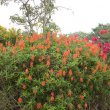
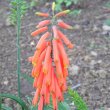
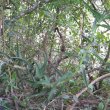
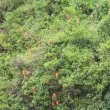
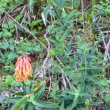
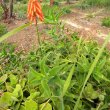


Comments
a true bulb aloe
I was at a specialist collector a few months ago and he showed me a truly bulb aloe. Leaves run flat along ground and die back in winter. Any thoughts on what speicies this is? Also my Longistyla leaves are grey green. Is this fine?
Regards
Bulb aloe
Yes your Aloe longistyla leaves should be grey green. As to the bulb aloe, I have not yet come across anything like that. There are succulents however, that look much like bulbs with leaves that can be either flat or upright, and some them do die back in winter. These are known as Epigeal (above ground) bulbs and species such as Albuca, Ledebouria and Ornithigalum could easily appear to be aloes. See Albuca nelsonii in the plant list.
Aloe Ciliaris
My plant has grown so tall and has very skinny (trunks) the stems. It has gotten so tall that its top heavy. I am not sure what to do. I do not want to loose this plant and need some advice. I
Aloe ciliarus very tall and skinny
Hi Diane
My sincere apologies for not having replied to your query as long time ago.
I have copied the first line from the information supplied above under the heading:
Specific Information:
'Aloe ciliarus is unique in being the only true climbing aloe.'
Does that answer your question?
Your aloe needs something to climb on for support. Like a tree or a shrub or a trellis.
Kind regards
Lorraine
Discuss this plant
Share knowledge, ask a question or give an experience.